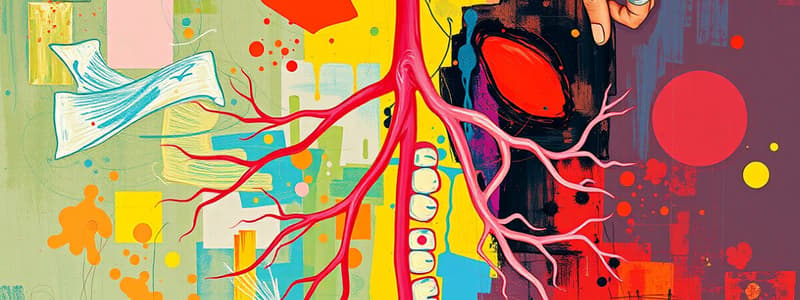Podcast
Questions and Answers
Capillaries are tiny, thin-walled vessels where ______ exchange and nutrient exchange occur.
Capillaries are tiny, thin-walled vessels where ______ exchange and nutrient exchange occur.
gas
The 'lub-dub' sound of the heart is produced by the closing of the heart ______ during the cardiac cycle.
The 'lub-dub' sound of the heart is produced by the closing of the heart ______ during the cardiac cycle.
valves
Passive immunity provides immediate, ______ protection against invading pathogens.
Passive immunity provides immediate, ______ protection against invading pathogens.
nonspecific
Physical barriers like the skin and ______ membranes serve as defenses against pathogens.
Physical barriers like the skin and ______ membranes serve as defenses against pathogens.
Phagocytes, such as neutrophils and ______, are specialized immune cells that engulf and destroy pathogens.
Phagocytes, such as neutrophils and ______, are specialized immune cells that engulf and destroy pathogens.
Chemoreceptors monitor the levels of carbon dioxide (CO2), oxygen (O2), and ______ in the blood.
Chemoreceptors monitor the levels of carbon dioxide (CO2), oxygen (O2), and ______ in the blood.
When CO2 levels increase, signals are sent to increase the respiratory rate and ______ to enhance oxygen intake.
When CO2 levels increase, signals are sent to increase the respiratory rate and ______ to enhance oxygen intake.
Red blood cells contain ______, a protein that binds oxygen and carbon dioxide.
Red blood cells contain ______, a protein that binds oxygen and carbon dioxide.
Platelets are cell fragments involved in blood ______.
Platelets are cell fragments involved in blood ______.
White blood cells are immune cells that defend the body against ______ and foreign invaders.
White blood cells are immune cells that defend the body against ______ and foreign invaders.
Study Notes
Respiratory System Regulation
- Chemoreceptors monitor carbon dioxide (CO2), oxygen (O2), and pH levels in the blood.
- Increased CO2 or decreased O2 levels trigger signals to enhance respiratory rate and depth.
- Decreased CO2 or increased O2 levels result in decreased respiratory activity.
- Factors influencing respiratory patterns include emotions, physical activity, and environmental conditions.
Clinical Relevance of Respiratory Disorders
- Respiratory disorders significantly affect health and quality of life.
- Common conditions include asthma, chronic obstructive pulmonary disease (COPD), pneumonia, and lung cancer.
Composition and Functions of Blood
- Blood circulates essential substances, delivering nutrients and removing wastes.
- Plasma constitutes about 55% of blood volume, composed of water, proteins, electrolytes, hormones, and wastes.
- Red blood cells (erythrocytes) transport O2 and CO2 via hemoglobin.
- White blood cells (leukocytes) are involved in immune responses, including phagocytosis and antibody production.
- Platelets (thrombocytes) play a critical role in blood clotting by adhering to injury sites and triggering clot formation.
Heart Sounds
- The "lub-dub" sounds are produced by heart valve closures during the cardiac cycle.
- "Lub" occurs with the closure of atrioventricular (AV) valves at the beginning of ventricular contraction.
- "Dub" is generated by the closure of semilunar valves at the end of systole when the ventricles relax.
Immune System: Passive (Innate) Immunity
- Passive immunity is the body’s immediate defense against pathogens and is present at birth.
- Physical barriers include skin and mucous membranes which prevent pathogen entry.
- Chemical barriers consist of stomach acid and antimicrobial enzymes in bodily fluids.
- Cellular defenses utilize phagocytes and natural killer (NK) cells to eliminate pathogens.
Neurons and Associated Cells
- Neurons transmit nerve impulses and consist of several components:
- Cell Body (Soma): Contains the nucleus and organelles.
- Dendrites: Receive signals from other neurons or sensory receptors.
- Axon: Conducts impulses away from the soma.
- Axon Terminal: Connects with other cells to transmit signals via neurotransmitters.
- Myelin Sheath: Insulates some axons, increasing impulse conduction speed.
Peripheral Nerves
- Peripheral nerves are bundles of nerve fibers connecting the central nervous system (CNS) to the body.
- They transmit sensory information to the CNS and motor commands from the CNS.
- Peripheral nerves consist of nerve fascicles, blood vessels, connective tissue, and supporting Schwann cells.
- Autonomic nerves serve internal organs, while somatic nerves control voluntary movements.
Nociceptors and Pain Sensation
- Nociceptors detect and transmit pain signals in response to harmful stimuli.
- They initiate protective reflexes to prevent further tissue injury and trigger inflammatory responses.
- Nociceptors can influence learning and memory related to pain.
Intracellular Hormone Receptors
- Intracellular receptors bind lipid-soluble hormones, regulating gene transcription and protein synthesis.
- Hormone binding induces conformational changes in receptors, activating downstream signaling pathways.
- Gene expression and enzyme activation/inhibition are regulated by these receptors, affecting cellular functions.
Major Types of Bones: Long Bones
- Long bones are characterized by an elongated shape with a diaphysis (shaft) and two epiphyses (ends).
- They are a key component of the appendicular skeleton, found in the limbs.
Studying That Suits You
Use AI to generate personalized quizzes and flashcards to suit your learning preferences.
Description
This quiz explores the role of chemoreceptors in the human respiratory system. It covers how changes in carbon dioxide and oxygen levels influence respiratory rate and depth. Test your understanding of the mechanisms that regulate breathing in response to various internal and external factors.



